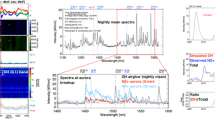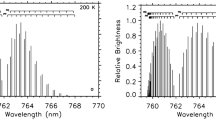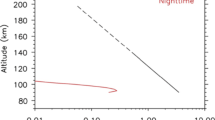Abstract
A SpectroMeter of Atmospheric RadiaTion (SMART) was developed and installed at the Xinglong station of the National Astronomical Observatories in Hebei province, China, which was supported by the Meridian Project [1]. The experimental tests of spectrometric observation of the hydroxyl emission and rotational temperature in China were conducted for the first time on the night of February 23, 2011 and the night of April 27, 2011, respectively. OH 6-2 band and OH 8-3 band spectra were measured and the rotational temperature was retrieved. Hourly average temperatures (186.82±6.40) K of OH 8–3 band and (178.07±6.73) K of OH 6–2 band were derived from the spectra observed on the night of February 23, 2011. Intensities and rotational temperature against local time were determined by the spectra measured in the whole night of April 27, 2011. The rotational temperature was consistent with the spatial average temperature of NRLMSISE00 empirical model at height 83–91 km and the average temperature of TIMED/SABER from April to May of seven years at height 83–91 km, with some discrepancies. The results showed that the new instrument and the retrieval method of the rotational temperature can give reasonable results of the airglow emission of OH and the temperature of mesopause.
Similar content being viewed by others
References
Wang C. New chains of space weather monitoring stations in China. Space Weather, 2010, 8: S08001
Offermann D, Gerndt R. Upper-mesosphere temperatures from OH*-emissions. Adv Space Res, 1990, 10(12): 217–221
Sivjee G G. Airglow hydroxyl emissions. Planet Space Sci, 1992, 40(2–3): 235–242
Scheer J. What can be learned from rotational temperatures derived from ground-based airglow observations about the aeronomy of the southern hemisphere. Adv Space Res, 1995, 16(5): 61–69
Gao H, Xu J Y, Wu Q. Seasonal and QBO variations in the OH nightglow emission observed by TIMED/SABER. J Geophys Res, 2010, 115: A06313
Baker D J, Stair A T. Rocket measurements of the altitude distributions of the hydroxyl airglow. Phys Scr, 1988, 37(4): 611–622
Bates D R, Nicolet M. The photochemistry of atmospheric water vapor. J Geophys Res, 1950, 55(3): 301–327
Pendleton W R, Jr, Espy P J, et al. Evidence for non-local-thermo-dynamic-equilibrium rotation in the OH nightglow. J Geophys Res. 1993, 98(A7): 11567–11579
Mukherjee G K, Parihar N. Measurement of rotational temperature at Kolhapur, India. Ann Geophys, 2004, 22(9): 3315–3321
Takahashi H, Batista P P, Buriti R A, et al. Response of the airglow OH emission temperature and mesopause wind to the atmospheric wave propagation over Shigaraki, Japan. Earth Planets Space, 1999, 51(7): 863–875
Sridharan R, Modi N K, Raju D P, et al. Multiwavelength daytime photometer-a new tool for the investigation of atmospheric processes. Meas Sci Technol, 1998, 9(4): 585–591
Oznovich I, Mcewen D J, Sivjee G G. Temperature and airglow brightness oscillations in the polar mesosphere and lower thermosphere. Planet Space Sci, 1995, 43(9): 1121–1130
Wang Y M, Wang Y J. The measurements of mesopause temperature by the synthetic spectra method (in Chinese). Chin J Space Sci, 1997, 17(4): 348–352
Sivjee G G, Dick K K, Feldman P D. Temporal variations in night-time hydroxyl rotational temperature. Planet Space Res, 1972, 20(2): 261–269
Nielsen K P, Sigernes F, Raustein E, et al. The 20-year change of the Svalbard OH-temperature. Phys Chem Earth, 2002, 27(6–8): 555–561
French W J R, Burns G B, Finlayson K, et al. Hydroxyl(6–2) airglow emission intensity ratios for rotational temperature determination. Ann Geophys, 2000, 18(10): 1293–1303
Suzuki H, Taguchi M, Kanai Y, et al. Fast spectrometer for ground-based observations of OH rotational temperature. Appl Opt, 2009, 48(6): 1119–1127
Phillips F, Burns G B, French W J R, et al. Determining rotational temperatures from the OH(8-3) band, and a comparison with OH(6–2) rotational temperatures at Davis, Antarctica. Ann Geophys, 2004, 22(5): 1549–1561
French W J R, Burns G B. The influence of large-scale oscillations on long-term trend assessment in hydroxyl temperatures over Davis, Antarctica. J Atmos Sol-Terr Phys, 2004, 66(6–9): 493–506
Yuan W, Xu J Y, Ma R P, et al. First observation of mesospheric and thermospheric winds by a Fabry-Perot interferometer in China. Chinese Sci Bull, 2010, 55(35): 4046
Li Q Z, Xu J Y, Yue J, et al. Statistical characteristics of gravity wave activities observed by an OH airglow imager at Xinglong, in northern China. Ann Geophys, 2011, 29(8): 1401–1411
Gao H, Xu J Y, Nee J B, et al. Longitudinal Distribution of O2 Nightglow Brightness Observed by TIEMD/SABER Satellite. Sci China Tech Sci, 2012, this special issue
Jiang G Y, Yuan W, Ning B Q, et al. A comparison of mesospheric winds measured by FPI and meteor radar located at 40N, Sci China Tech Sci, 2012, this special issue
Picone J M, Hedin A E, Drob D P, et al. NRLMSISE00 empirical model of the atmosphere: Statistical comparisons and scientific issues. J Geophys Res, 2002, 107(A12): 1468
Cosby P C, Slanger T G. OH spectroscopy and chemistry investigated with astronomical sky spectra. Can J Phys, 2007, 85(2): 77–99
Rousselot P, Lidman C, Cuby J G, et al. Night-sky spectral atlas of OH emission lines in the near-infrared. Astron Astrophys, 2000, 354: 1134–1150
Van der Loo M P J, Groenenboom G C. Theoretical transition probabilities for the OH Meinel system. J Chem Phys, 2007, 126(11): 114314
Greet P A, French W J R, Burns G B, et al. OH (6-2) spectra and rotational temperature measurements at Davis, Antarctica. Ann Geophys, 1998, 16(1): 77–89
Xu J Y, Liu H L, Yuan W. Mesopause structure from Thermosphere, Ionosphere, Mesosphere, Energetics, and Dynamics (TIMED)/Sounding of the Atmosphere Using Broadband Emission Radiometry (SABER) observations. J Geophys Res, 2007, 112: D09102
Xu J Y, Smith A K, Jiang G Y, et al. Strong longitudinal variations in the OH nightglow. Geophys Res Lett, 2010, 37: L21801
Author information
Authors and Affiliations
Corresponding author
Rights and permissions
About this article
Cite this article
Zhu, Y., Xu, J., Yuan, W. et al. First experiment of spectrometric observation of hydroxyl emission and rotational temperature in the mesopause in China. Sci. China Technol. Sci. 55, 1312–1318 (2012). https://doi.org/10.1007/s11431-012-4824-7
Received:
Accepted:
Published:
Issue Date:
DOI: https://doi.org/10.1007/s11431-012-4824-7




